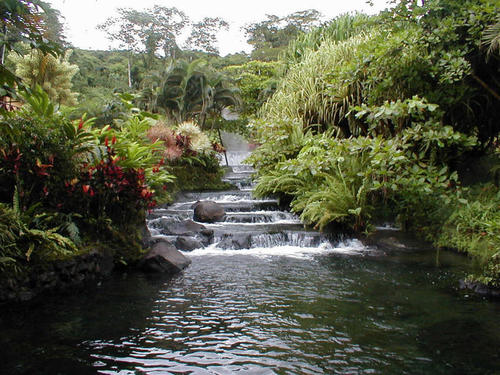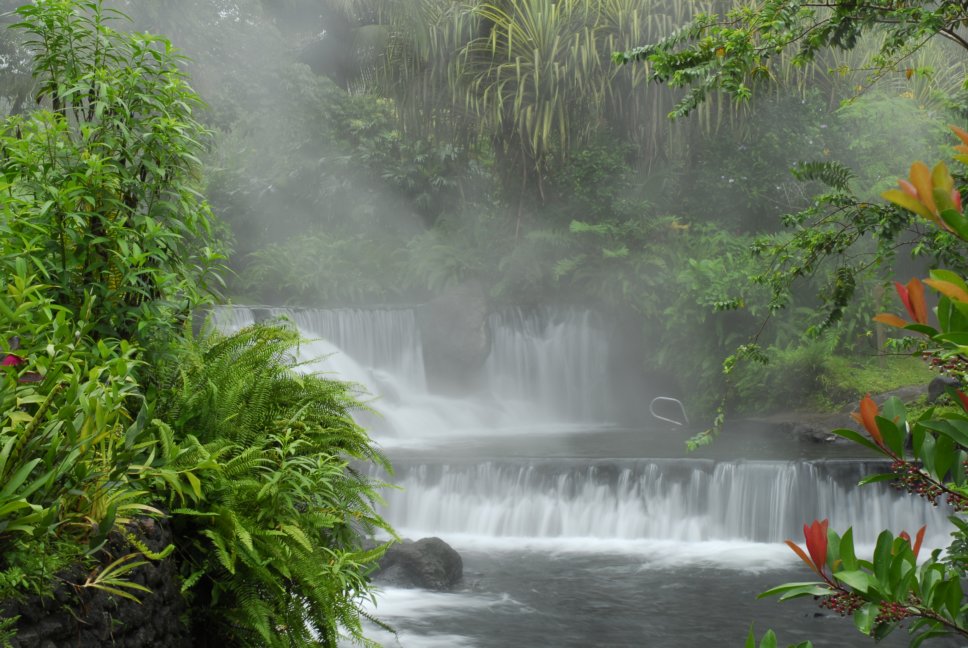Costa Rica Travel News – I’m facing a sprawling maze of waterfalls and pools of varying temperatures set into the foothills of northwest Costa Rica’s Arenal Volcano. All around water cascades over glossy black rocks and wooden bridges criss-cross over waterfalls.
 A volcano-studded sliver of land wedged between Nicaragua and Panama, facing both the Caribbean Sea and Pacific Ocean, Costa Rica packs a powerful eco-punch. The tiny country manages to pack in five per cent of all species known on earth, and 25 per cent of its luscious landscape is protected through national parks and reserves like this one.
A volcano-studded sliver of land wedged between Nicaragua and Panama, facing both the Caribbean Sea and Pacific Ocean, Costa Rica packs a powerful eco-punch. The tiny country manages to pack in five per cent of all species known on earth, and 25 per cent of its luscious landscape is protected through national parks and reserves like this one.
Taking to the waters for relaxation and, for some, in the hope of healing, is not a new-age trend. Here at Tabacon Thermal Resort, it’s but one of a buffet of adventure activities on offer in the surrounding rainforests, including ziplining, quad biking, horse riding and whitewater rafting.
With all that exertion, the chance to sit and do nothing at all is a welcome reward.
Tabacon is the Ritz of hot spring resorts. A natural geothermal river runs through the property, forming mineral-rich pools and waterfalls along the way, made more user-friendly by pathways, stepping-stones and borders. The springs here are completely natural, instead of relying on pumps like other resorts in the area.
We’ve driven three hours from the capital of San Jose to get here past a wild tapestry of rainforest, cattle ranches and candy-coloured houses. A stop in Sarchi allowed for a spot of handicraft shopping. This is the home of carettas (elaborately painted ox carts) that were traditionally used for transporting coffee down to the coast for export. The town even lays claim to having the world’s largest ox cart, at 18m.
The rest of the morning is consumed by coffee plantations, farmland and small towns built around the requisite church and soccer field – always side by side – whizzing past our mini bus windows.
Lunch is taken in La Fortuna, with views of Arenal’s looming cauldron. It’s a little shy today, with its peak shrouded by muggy clouds. Arenal is young by volcano standards (about 7000 years) though it’s one of the world’s most active. The statistics are a little intimidating: the 1633m tall volcano can spew 1000C lava at 200km/h. In 1968 it exploded with gusto, killing 87 people and wiping out three small villages in its path. El Borio on the eastern side was untouched and so was renamed La Fortuna, meaning “the fortunate”.
Fortunately for us, it’s been dormant since October 2010 and to add an extra level of reassurance, our guide tells us there are now cameras installed inside the crater to keep a close eye on any bubbling emotions.
Upon arriving at Tabacon, we exchange a refundable deposit for a fluffy towel and locker key to explore uninhibited. There are stairs and a handrail to help you in, and a life ring in case of emergency, though with most pools less than a metre deep I can’t imagine they get used very often.
I try a few different pools; cool rain hits the water creating mists of steam and a slightly spooky atmosphere.
When the heat becomes overwhelming, I cool off with a walk through the gardens of eye-popping heliconias and other tropical blooms with colours so vivid you’d swear a filter had been applied over the entire place.
In one of the main pools, a group is sitting behind a waterfall in a man-made cave, sipping cocktails. In others, solo travellers sit silently with their eyes closed, enjoying the natural hydrotherapy session.
Tabacon’s eco-friendly and carbon-neutral rooms are completely hidden from sight. The resort welcomes day-trippers by the busload, allocating them into timeslots. We’ve opted for the afternoon shift, which isn’t too busy but I can imagine this place would heave in peak time.
By CELESTE MITCHELL, http://www.heraldsun.com.au/

